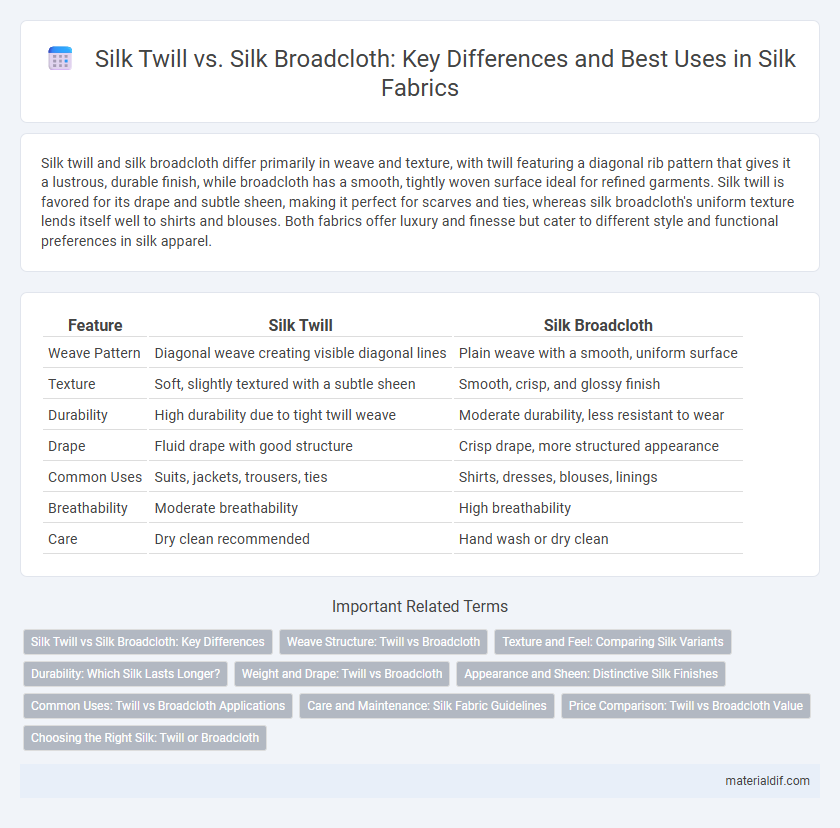Silk twill and silk broadcloth differ primarily in weave and texture, with twill featuring a diagonal rib pattern that gives it a lustrous, durable finish, while broadcloth has a smooth, tightly woven surface ideal for refined garments. Silk twill is favored for its drape and subtle sheen, making it perfect for scarves and ties, whereas silk broadcloth's uniform texture lends itself well to shirts and blouses. Both fabrics offer luxury and finesse but cater to different style and functional preferences in silk apparel.
Table of Comparison
| Feature | Silk Twill | Silk Broadcloth |
|---|---|---|
| Weave Pattern | Diagonal weave creating visible diagonal lines | Plain weave with a smooth, uniform surface |
| Texture | Soft, slightly textured with a subtle sheen | Smooth, crisp, and glossy finish |
| Durability | High durability due to tight twill weave | Moderate durability, less resistant to wear |
| Drape | Fluid drape with good structure | Crisp drape, more structured appearance |
| Common Uses | Suits, jackets, trousers, ties | Shirts, dresses, blouses, linings |
| Breathability | Moderate breathability | High breathability |
| Care | Dry clean recommended | Hand wash or dry clean |
Silk Twill vs Silk Broadcloth: Key Differences
Silk twill features a distinctive diagonal weave, giving it a textured surface and increased durability compared to the smooth, tightly woven silk broadcloth that has a flat finish. Silk twill offers more drape and wrinkle resistance, making it ideal for structured garments, whereas silk broadcloth is favored for its crisp feel and is commonly used in shirts and blouses. The differences in weave pattern directly affect the fabric's appearance, weight, and suitability for various fashion applications.
Weave Structure: Twill vs Broadcloth
Silk twill features a diagonal weave pattern that enhances fabric durability and provides a distinctive texture with subtle sheen, making it ideal for garments requiring drape and resilience. Silk broadcloth uses a plain weave characterized by tight, closely woven threads that create a smooth, crisp surface, perfect for formal shirts and lightweight apparel. The twill weave's diagonal ribs contrast with the broadcloth's flat, uniform appearance, influencing both the fabric's aesthetic and tactile qualities.
Texture and Feel: Comparing Silk Variants
Silk twill features a distinctive diagonal weave that creates a textured surface with a slight sheen, offering a soft yet durable feel ideal for structured garments. Silk broadcloth has a tightly woven, plain weave resulting in a smooth, crisp texture with a luminous finish, perfect for elegant shirts and blouses. The tactile difference lies in twill's pronounced weave pattern versus broadcloth's sleek and uniform surface.
Durability: Which Silk Lasts Longer?
Silk twill features a diagonal weave that enhances its tensile strength and resistance to wear, making it more durable than silk broadcloth, which has a tight, plain weave prone to wrinkles and abrasion. The denser construction of silk twill fibers contributes to greater longevity in garments exposed to frequent use. Consequently, silk twill is the preferred choice for items requiring higher durability without sacrificing the luxurious feel of silk.
Weight and Drape: Twill vs Broadcloth
Silk twill exhibits a heavier weight and a more pronounced diagonal weave, resulting in a fabric with excellent drape and durability, ideal for structured garments. Silk broadcloth is lighter and smoother with a plain weave, offering a crisp, matte finish that drapes softly, making it suitable for lightweight shirts and blouses. The weight and weave differences between silk twill and broadcloth directly influence their aesthetic, texture, and garment application.
Appearance and Sheen: Distinctive Silk Finishes
Silk twill showcases a diagonal weave pattern that creates a textured surface with a subtle sheen, adding depth and visual interest to the fabric. In contrast, silk broadcloth features a tightly woven, smooth surface with a crisp, matte finish that reflects light evenly for a refined, polished look. The distinctive finishes of twill and broadcloth highlight silk's versatility in appearance, catering to different aesthetic preferences and garment styles.
Common Uses: Twill vs Broadcloth Applications
Silk twill is commonly used for luxury garments such as suits, jackets, and scarves due to its distinctive diagonal weave that offers durability and a subtle sheen. Silk broadcloth, known for its smooth, tightly woven texture, is ideal for formal shirts, blouses, and lingerie, providing a crisp, elegant appearance with a soft hand feel. Both fabrics serve high-end fashion but differ in application based on texture and structure preferences.
Care and Maintenance: Silk Fabric Guidelines
Silk twill requires gentle care with mild detergent and cold water to preserve its diagonal weave and sheen, avoiding harsh agitation that can damage fibers. Silk broadcloth demands careful hand washing or dry cleaning to maintain its smooth, tight plain weave and prevent shrinking or distortion. Both fabrics benefit from air drying away from direct sunlight and low-heat ironing with a protective cloth to extend their lifespan.
Price Comparison: Twill vs Broadcloth Value
Silk twill typically commands a higher price than silk broadcloth due to its complex weaving technique that enhances durability and imparts a distinctive diagonal texture. Silk broadcloth, while more affordable, offers a smoother finish and lighter feel, making it suitable for different garment styles but with less structural resilience. The value difference hinges on the weaving complexity and durability, where twill's premium cost reflects its enhanced lifespan and textural uniqueness compared to the more economical broadcloth.
Choosing the Right Silk: Twill or Broadcloth
Silk twill features a diagonal weave that offers durability, texture, and a subtle sheen, making it ideal for structured garments and tailored pieces. Silk broadcloth has a smooth, tight plain weave that provides a crisp finish and lightweight feel, perfect for blouses and shirts requiring breathability and softness. Selecting between silk twill and broadcloth depends on the desired texture, drape, and durability for your specific garment or project.
Silk twill vs Silk broadcloth Infographic

 materialdif.com
materialdif.com